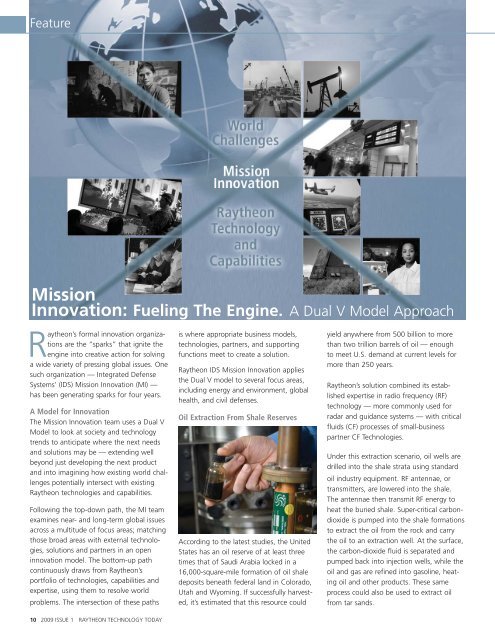2009 Issue 1 - Raytheon
2009 Issue 1 - Raytheon
2009 Issue 1 - Raytheon
You also want an ePaper? Increase the reach of your titles
YUMPU automatically turns print PDFs into web optimized ePapers that Google loves.
Feature<br />
Mission<br />
Innovation: Fueling The Engine. A Dual V Model Approach<br />
<strong>Raytheon</strong>’s formal innovation organizations<br />
are the “sparks” that ignite the<br />
engine into creative action for solving<br />
a wide variety of pressing global issues. One<br />
such organization — Integrated Defense<br />
Systems’ (IDS) Mission Innovation (MI) —<br />
has been generating sparks for four years.<br />
A Model for Innovation<br />
The Mission Innovation team uses a Dual V<br />
Model to look at society and technology<br />
trends to anticipate where the next needs<br />
and solutions may be — extending well<br />
beyond just developing the next product<br />
and into imagining how existing world challenges<br />
potentially intersect with existing<br />
<strong>Raytheon</strong> technologies and capabilities.<br />
Following the top-down path, the MI team<br />
examines near- and long-term global issues<br />
across a multitude of focus areas; matching<br />
those broad areas with external technologies,<br />
solutions and partners in an open<br />
innovation model. The bottom-up path<br />
continuously draws from <strong>Raytheon</strong>’s<br />
portfolio of technologies, capabilities and<br />
expertise, using them to resolve world<br />
problems. The intersection of these paths<br />
10 <strong>2009</strong> ISSUE 1 RAYTHEON TECHNOLOGY TODAY<br />
is where appropriate business models,<br />
technologies, partners, and supporting<br />
functions meet to create a solution.<br />
<strong>Raytheon</strong> IDS Mission Innovation applies<br />
the Dual V model to several focus areas,<br />
including energy and environment, global<br />
health, and civil defenses.<br />
Oil Extraction From Shale Reserves<br />
According to the latest studies, the United<br />
States has an oil reserve of at least three<br />
times that of Saudi Arabia locked in a<br />
16,000-square-mile formation of oil shale<br />
deposits beneath federal land in Colorado,<br />
Utah and Wyoming. If successfully harvested,<br />
it’s estimated that this resource could<br />
yield anywhere from 500 billion to more<br />
than two trillion barrels of oil — enough<br />
to meet U.S. demand at current levels for<br />
more than 250 years.<br />
<strong>Raytheon</strong>’s solution combined its established<br />
expertise in radio frequency (RF)<br />
technology — more commonly used for<br />
radar and guidance systems — with critical<br />
fluids (CF) processes of small-business<br />
partner CF Technologies.<br />
Under this extraction scenario, oil wells are<br />
drilled into the shale strata using standard<br />
oil industry equipment. RF antennae, or<br />
transmitters, are lowered into the shale.<br />
The antennae then transmit RF energy to<br />
heat the buried shale. Super-critical carbondioxide<br />
is pumped into the shale formations<br />
to extract the oil from the rock and carry<br />
the oil to an extraction well. At the surface,<br />
the carbon-dioxide fluid is separated and<br />
pumped back into injection wells, while the<br />
oil and gas are refined into gasoline, heating<br />
oil and other products. These same<br />
process could also be used to extract oil<br />
from tar sands.

















